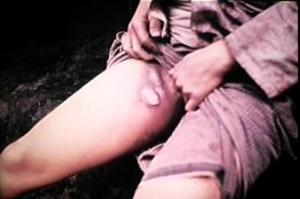Ring Around the Rosy. A Pocket Full of Posies. Ashes, Ashes, We All Fall Down.
Today when children sing this well-known rhyme it doesn’t stir up the fear that it once did. The seemingly innocent song refers to the bubonic plague, known as the Black Death that swept through Europe, Asia, and Africa in the 1300’s; historically the second of its kind. When a third pandemic occurred in the late 1880’s, the bubonic plague expanded to Australia, North and South America by way of steamships. With worldwide exposure, it has been impossible for the infection to be completely irradiated.
The Bubonic Plague – Ring Around The Rosy:
The bubonic plague is an infection caused primarily from a bite of a plague-infected flea and/or a transmission from an infected rodent. As the first line of the rhyme hints, the infection of the bubonic plague appears as raised lesions, normally red in color, often grouping together appearing ring-like. The infection is known to travel through the lymphatic system in the human body, and the most common place to find the lesions, called buboes, is in areas of the neck, armpits and groin, as they contain large lymph nodes.
The bubonic plague’s symptoms may not occur until 2-5 days from the initial contact with an infected source. High fevers, chills, aches, headaches, sensitive areas on the skin, and stomach distress, may all be present and could give the false impression of a flu-like ailment. The infection from bubonic plague is necrotic, and as the tissue dies pain around the lesions increases. In the end stages of the bubonic plague lesions may fester and occasionally rupture, further increasing the exposure risk.
The Bubonic Plague – A Pocket Full Of Posies:
With the large amount of death found in the streets in areas affected by Black Death, survivors would place herbs and sweet smelling flowers into pouches carrying them close to their face to mask the smell of decay. This was the inspiration for the line in the rhyme: A Pocket Full Of Posies. At that time, it was believed that there was no cure for the bubonic plague.
Fortunately, modern medicine has been more effective in handling the bubonic plague. Being a bacterial infection the plague can be treated with powerful antibiotics. Researchers recognize that many stains of the bacteria exist, and treatment specific to a strain is essential for total recovery. Advances in modern science allow laboratory testing to be done in order to identify and treat with the most effective antibiotic. Today, most modern cases of the bubonic plague can be cured if detected and treated within the first 24-72 hours.
In addition, for most of the 20th century a bubonic plague vaccine was widely used. The vaccine’s effectiveness was questionable and occasionally caused more health issues than it solved. It is now given primarily to physicians and medical support staffs that are exposed to the infection, or those who are at higher than normal risk.
The Bubonic Plague – Ashes, Ashes, We All Fall Down:
The Black Death was effectively contained only after the massive fire of London, which cremated the bodies of the dead and killed any remaining infection. As with the old world bubonic cases, cremation remains the best method to destroy any remaining infection.
Today health organizations across the world keep close count of reported cases each year. Encouraging numbers show that occurrences of the bubonic plague are decreasing every year and with it, the number of fatalities. This is evident in the accounting of bubonic plague cases by the World Health Organization (WHO). One recent report states that, in 2003, 9 countries reported cases of bubonic plague. Of the 2118 cases reported, only 18% resulted in death. This was a decrease from the same organization’s report a year earlier.
The Bubonic Plague – Another Turn Around the Rosy:
With the threat of terroristic activity continuing to increase, the fear is that the bubonic plague may be used in biological warfare. Organizations like the WHO, National Institute of Health, and the Center for Disease Control, have put in place training and precautions to prevent such attacks, however the effectiveness of such plans is unknown. The medical and scientific communities remain committed to providing better solutions and preventatives measures.
Following universal health precautions on an individual level will help prevent the spread of the bubonic plague. Hand washing, pest control around the home and pets, and remaining separate from family and friends when ill, will help to prevent the spread of all diseases, not just the fatal ones.
Sources:
Bubonic Plague.www.webmd.com
Bubonic Plague.www.wikipedia.com.
Dufel, MD, FACEP, Susan E and Cronin, MD, Deirdre. CBRNE – Plague: Treatment and Medication.www.emedicine.medscapes.com.
MedlinePlus.Plague.www.nlm.nih.gov.
Plague.www.who.int.
Ring Around the Rosy – Origins of “Ring around the rosy” in English history.www.rhymes.org.uk.
World Health Organization. Plague Manual: epidemiology, distribution, surveillance, and control. WHO/CDS/CSR/EDC/99.2. www.who.int.
World Health Organization. Weekly Epidemiological Record. No.33, 2004, 79, 301-308.




